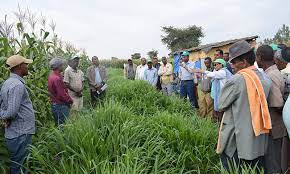What is Push-Pull Technology?
 |
| Photo cred: ICIPE |
This is a technique, which entails planting two companion crops. One crop emits a chemical that pushes pests while the other crop attracts pests. Originally, the Push-Pull method was initiated to control stem-borers and Striga weed in cereal crops. Currently, vegetables such as kales and tomatoes are being incorporated in the Push-Pull method.
In a Push-Pull technique, one plants Desmodium between the rows of either cereal crops or vegetables and drought-resistant grass such as brachiaria or Napier grass around these crops. Desmodium produces a chemical that scares stem borers in cereal crops. For this reason, it acts as a ‘Push’. On the other hand, brachiaria lures stem-borer moths to lay their eggs on it. However, it offers limited survival of the stem-borer larva. As a result, it acts as a ‘Pull”.
Additionally, the roots of Desmodium release a chemical that suppresses Striga weed. This implies that the chemical depletes the seeds of Striga in the soil. Desmodium is one of the nitrogen-fixing legumes and enhances carbon removal in the ground.
The technology protects the soil moisture content, enhances soil organic matter, and prevents soil erosion. It also increases the number of under- and above-ground microorganisms and insects like bees.
Based
on the data from ICIPE, not less than 160,000 small-scale farmers are practicing
Push-Pull technology, and have realized a tremendous increase in their cereal
crop produce (ICIPE, 2019). The push-Pull method is being practiced in African
countries, namely Kenya, Uganda, Ethiopia, Burundi, Tanzania, Rwanda, Zimbabwe,
Malawi, and Zambia. Download the app through this link Push-Pull Technology
Reference
ICIPE. 2019. Climate-Smart Push-Pull Curriculum for Farmer Field Schools. International Centre of Insect Physiology and Ecology, Nairobi, Kenya.
 |
| Photo Credit: Twigahead Farming & Processing Ltd |



Comments
Post a Comment